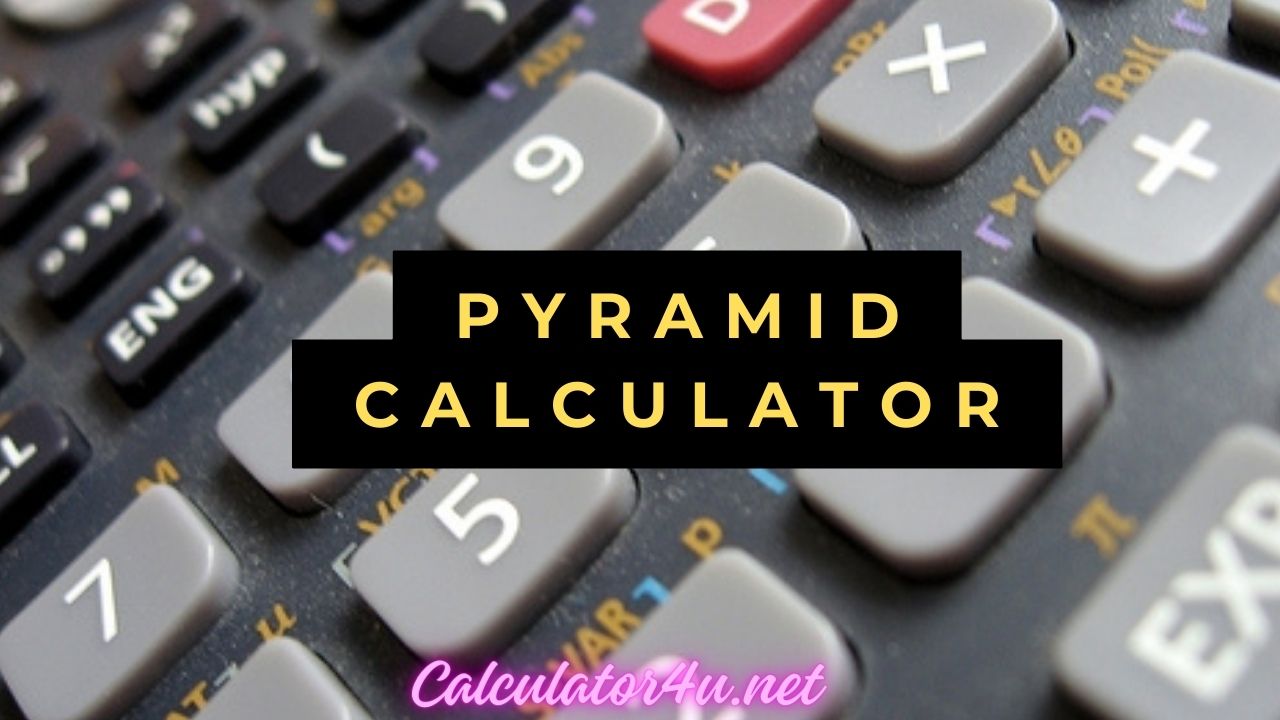Pyramid Calculator
- Profit Calculator
- Probability Density Function Calculator
- Prime Number Calculator
- Prime Factorization Calculator
Pyramid Calculator with Steps
Unlock the mysteries of pyramid geometry with our Pyramid Calculator! Compute volume, surface area, and other essential parameters effortlessly. Master pyramid calculations and explore ancient architectural wonders today!
Table of Contents
Pyramid Calculator
Welcome to our Pyramid Calculator guide! Pyramids are fascinating geometric structures that have captured human imagination for millennia. From the iconic pyramids of Egypt to modern architectural wonders, pyramids are symbols of strength, stability, and mystery. In this article, we’ll delve into the intricacies of pyramid geometry and demonstrate how to use our specialized calculator to compute various pyramid parameters with accuracy and ease.
Pyramid Calculator Overview
What is Pyramid Geometry?
A pyramid is a polyhedron formed by connecting a polygonal base and a point called the apex. The most common types of pyramids are:
- Square Pyramid: Base is a square.
- Triangular Pyramid: Base is a triangle.
- Pentagonal Pyramid: Base is a pentagon.
- Hexagonal Pyramid: Base is a hexagon.
Importance of Pyramid Calculations
Understanding pyramid geometry and calculations is essential for various applications, including:
- Architecture: Designing and constructing buildings with pyramid-shaped elements.
- Engineering: Analyzing and modeling structural stability of pyramid-like structures.
- Mathematics: Solving geometric problems and exploring spatial relationships.
- History: Studying ancient civilizations and architectural marvels like the Egyptian pyramids.
How the Calculator Works
Our Pyramid Calculator simplifies pyramid calculations by accepting key parameters such as base type, base dimensions, height, and calculates essential pyramid properties like volume, surface area, and slant height. Simply input the required parameters, and the calculator will provide instant results.
A Pyramid Calculator helps in calculating various properties of a pyramid, such as its volume, surface area, and other dimensions, based on the given inputs.
How to Use the Pyramid Calculator
- Choose the type of pyramid you want to calculate (e.g., square pyramid, triangular pyramid).
- Enter the required dimensions or measurements based on the chosen pyramid type.
- Click on the “Calculate” button to determine the volume, surface area, and other properties of the pyramid.
Calculator:
Type of Pyramid: [Dropdown Menu – Square Pyramid, Triangular Pyramid, etc.]
Dimensions/Measurements:
- Base Length: [__________] (Enter the length of the base)
- Base Width: [__________] (Enter the width of the base, if applicable)
- Height: [__________] (Enter the height of the pyramid)
[Calculate]
Example:
Let’s say we want to calculate the volume and surface area of a square pyramid with a base length of 10 units and a height of 8 units.
Choose “Square Pyramid” from the dropdown menu, enter 10 for the Base Length, and enter 8 for the Height. Click “Calculate.”
The calculator will display the volume and surface area of the square pyramid based on the given dimensions.
Step-by-Step Guide to Using the Calculator
- Select Base Type: Choose the type of pyramid base (Square, Triangle, Pentagon, Hexagon) from the dropdown menu.
- Enter Base Dimensions: Input the dimensions of the base (side length, radius) depending on the selected base type.
- Enter Height: Input the height of the pyramid.
- Initiate Calculation: Click the “Calculate” button to perform pyramid calculations.
- Review Result: Examine the computed volume, surface area, and other parameters displayed by the calculator.
Practical Applications
Understanding pyramid calculations has practical applications in various real-world scenarios, such as:
- Architecture: Estimating materials and costs for pyramid-shaped structures.
- Engineering: Analyzing load-bearing capacities and stability of pyramid-like constructions.
- Archaeology: Studying ancient pyramids and deciphering historical and cultural significance.
- Education: Enhancing geometric understanding and problem-solving skills through hands-on activities and experiments.
Advantages of Using the Calculator
- Accuracy: Provides precise pyramid calculations based on established geometric formulas.
- Efficiency: Saves time and effort by automating complex mathematical computations.
- Versatility: Supports a wide range of pyramid types and configurations, making it suitable for diverse applications.
FAQs
Q: What is a pyramid?
A: A pyramid is a polyhedron formed by connecting a polygonal base and a point called the apex. Common types include square, triangular, pentagonal, and hexagonal pyramids.
Q: What are the key parameters required for pyramid calculations?
A: The key parameters include base type, base dimensions (side length, radius), and height of the pyramid.
Q: Why are pyramid calculations important?
A: Understanding pyramid geometry and calculations is essential for architecture, engineering, mathematics, history, and education, enabling comprehensive analysis and exploration of pyramid-shaped structures and concepts.
Q: How does the Pyramid Calculator work?
A: The calculator accepts key pyramid parameters as input and computes essential properties such as volume, surface area, and slant height using established geometric formulas and algorithms.
Q: Can the calculator handle different types of pyramid bases?
A: Yes, the calculator supports various pyramid base types including square, triangular, pentagonal, and hexagonal, providing accurate calculations based on the selected base type.
Conclusion
In conclusion, our Pyramid Calculator offers a user-friendly and efficient tool for exploring pyramid geometry and performing essential calculations with precision. By following the steps outlined in this guide and utilizing the calculator’s features, you can enhance your understanding of pyramid structures and apply this knowledge to various architectural, engineering, and mathematical tasks.

